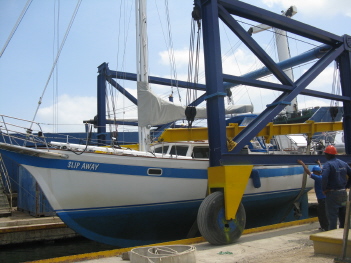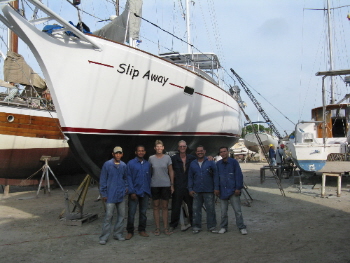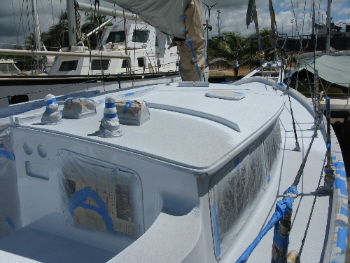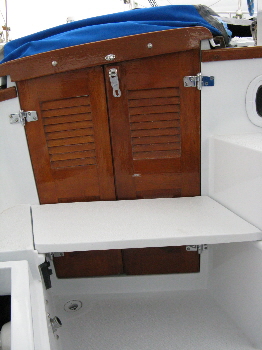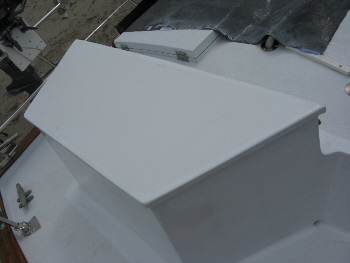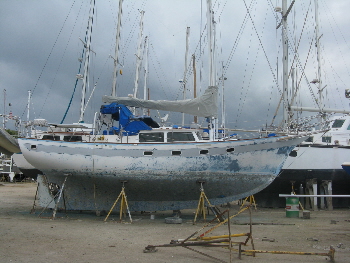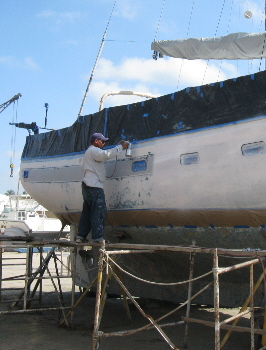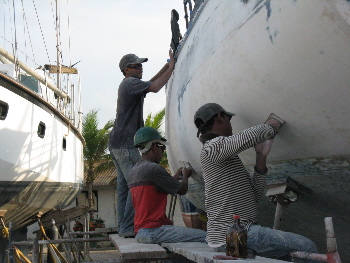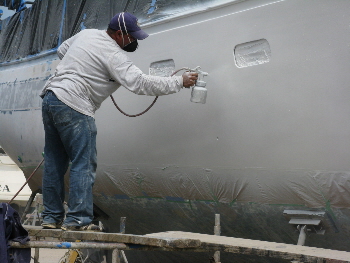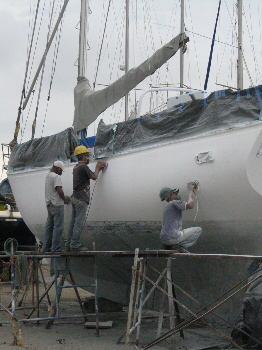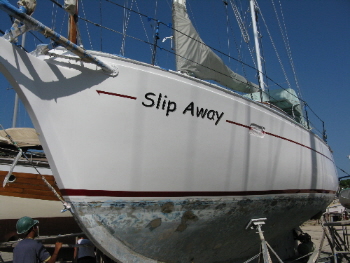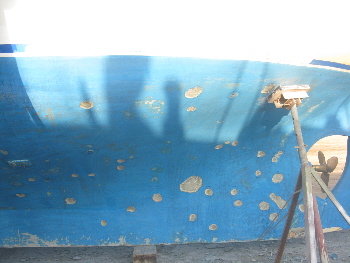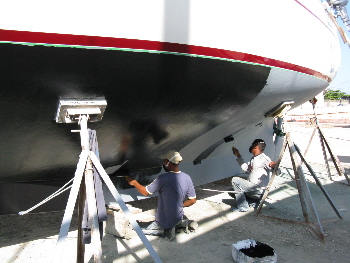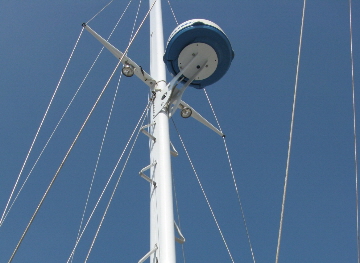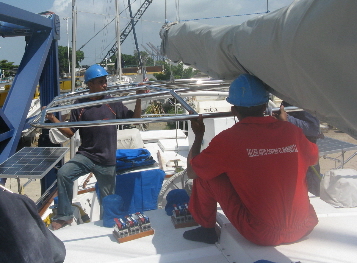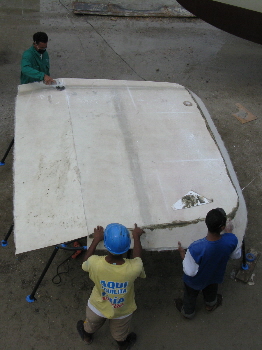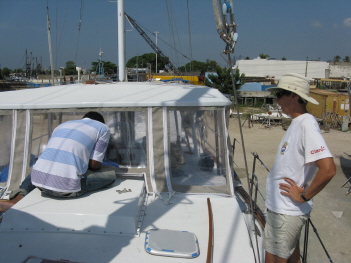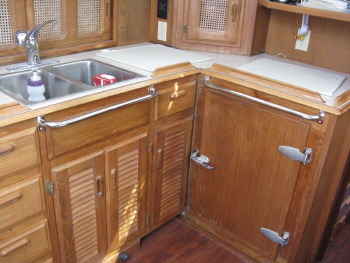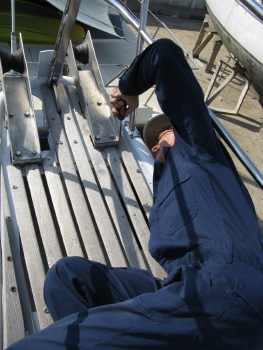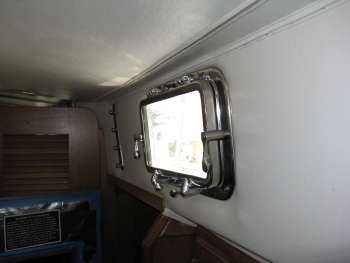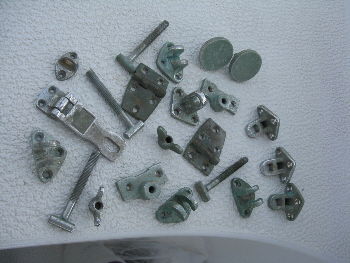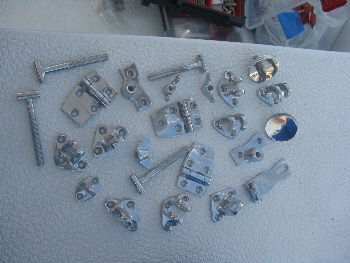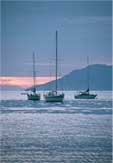
Current Location
(enter callsign KG6NNZ)
Refitting in Cartagena, Colombia - August 2009 to January 2010
The boat projects completed in Cartagena, Colombia, would best be described as a "facelift." By now, we had owned Slip Away for eight years and sailed her over 18,500 nautical miles. We had done regular maintenance and a number of upgrades along the way, but she really needed some work on her appearance.
Slip Away is over 30 years old, and she needed new paint and/or gelcoat on the topsides, hull and bottom. Additionally, the mizzen mast and boom needed paint, and our canvas dodger/bimini/cockpit enclosure was at the end of its useful life. Those were the big jobs, and of course, there were numerous other smaller projects that needed to be done.
Cartagena, Colombia, has a good reputation for getting quality boat work done for reasonable prices. We made up our "to-do" list, arranged our haul-out at the Ferroalquimar Shipyard, and contracted with several local vendors to do the work. Flavit Bernate Moreno and his crew did the lion's share of the work - all the fiberglassing, gelcoating and painting. Bianney Torres welded the frame for our new bimini hard top, Saul Castro helped us with some smaller stainless and welding jobs, and the Herrera brothers (Renzon & Francisco) sewed the new canvas/strataglass cockpit enclosure.
Slip Away was hauled out in late August, and shortly thereafter, we flew back to the States for six weeks to visit friends and family. We arranged some of the work before we left for the States, but we insisted that most of it wait until we got back from our trip because we wanted to supervise. We returned in early October and spent the next three months up to our ears in boat projects. It was a lot of work, but Slip Away looks fabulous!
Before and after photos:
|
|
|
Painting the Topsides
Rich had already done some painting on the cabin-tops and decks, but the cockpit and a couple other small areas still needed to be done. We also were not happy with the non-skid paint additive we used on the decks - they were slippery when wet - and we had a few fiberglass jobs to do on the decks and in the cockpit, so we decided to just start over and paint all the topside surfaces again. The additional fiberglass projects included:
- New anchor windlass installation. Our old windlass had gotten way too finicky, so our ancient "Monica Marine" windlass came out, and we installed a new Lofrans Tigres. Installing the new windlass required cutting new holes in the deck and filling the ones from the old windlass.
- New manual bilge pump installation. The old manual bilge pump quit working and the new one didn't fit in the old hole, so again, they patched the old hole (in the cockpit) and Rich cut out a new one.
- Re-built propane/storage box on aft deck. Due to the height of our old aft deck box, we were only able to carry half-size (10 lb.) propane tanks. Although we never ran out of propane, that was always a nagging concern for us when we were away from civilization for an extended period. Our initial idea was just to raise the height of the existing box, but Flavit and crew redesigned it to give us not only the height for the bigger propane tanks but also some extra storage space (which is always in demand on a boat).
- Additional cockpit seat fabrication. Slip Away has a pretty comfortable cockpit for hosting happy hour when we're cruising, but we had an idea for adding a removable seat in front of the entrance to the aft cabin. It was an easy task for Flavit and crew to design and install it.
|
|
|
|
Re-Gelcoating the Hull
Most boats come out of the factory with gelcoat on the hull. Gelcoat can last a long time (20+ years), and when it gets old and dull, most folks paint over it because re-gelcoating can be very expensive. Slip Away's hull had been dull for quite a while, and although we considered painting it, Cartagena is well known for doing good gelcoat work. We could have our hull re-gelcoated here for a fraction of what it would have cost to have it painted in the States. Slip Away's hull is now bright and shiny, and she's sporting some new colors. Instead of the big blue Islander Freeport stripe, we went with a smaller accent stripe in maroon ("vino tinto" or "red wine" in Spanish).
|
|
|
|
|
|
|
|
Bottom Paint and Repair
Painting the bottom is a regular maintenance item on a boat. It had been a couple of years since we had Slip Away's bottom painted, so it was time to do it again. We also had some blisters that needed to be repaired, so the plan was to strip the bottom down to the fiberglass, fix the blisters, apply a new epoxy barrier coat (Interlux 2000E) to help prevent new blisters, and paint with antifouling. While we were back in the States, Flavit ground out the blisters to let them dry before starting on the repair work when we returned in October. Work on the bottom also included moving the engine exhaust from below to above the water line (at the recommendation of an engine mechanic in Florida), so once again, we were filling an old hole and cutting a new one.
|
|
|
|
Mizzen Mast & Boom The paint on our mizzen mast was flaking badly and looked unsightly; the boom wasn't nearly as bad, but it needed painting, too. We also wanted to install some mast steps and a backup VHF antenna on top of the mizzen mast, which required running wire in it, so we removed the mizzen mast to do this work. Rich took photos of all the cleats, blocks and other hardware installed on the mast and boom, and then removed everything for painting. When the mast and boom were painted, he used the photos to guide his reinstallation of all the hardware. |
|
Hardtop Bimini & Cockpit
Enclosure
When we bought Slip Away, she had a relatively new canvas dodger and bimini, with a full cockpit enclosure, a feature we absolutely loved in cold or rainy weather. The canvas dodger and bimini served us well, but in the last year, it was really showing signs of wear - several of the zippers were falling apart, and the canvas was getting so thin we could almost see through it. We had been lusting after a hard-top bimini, and Cartagena was the perfect place to have one built. Although we could have used our old dodger and bimini frame, we decided to start from scratch and re-design for a variety of reasons, the primary ones being that the old bimini was too tall and interfered with the main sheet, and the height of the old dodger was right at our eye level and obstructed forward visibility.
Bianney Torres has a very good reputation for doing stainless work in Cartagena. We told him our ideas, and he did an outstanding job of designing the bimini frame. We contracted with him to do the work in August before we left for the U.S., and when we returned in October, the frame was ready to be fitted to the cockpit. After the frame was fitted, Flavit hired a guy named Elvis, to build the hard top. Once that job was completed, the frame and the top were installed on Slip Away, and after that Renzon and Francisco Herrera made a pattern and sewed the cockpit enclosure from canvas and strataglass.
|
|
|
|
Other Miscellaneous Projects
- Installed two additional solar panels on top of the new fiberglass bimini.
- Installed anchor troughs on bowsprit to better accommodate two anchors.
- Replaced port side hatch - across from engine room with a beautiful Newfound Metals Hatch.
- Re-galvanized stern anchor, stern anchor chain, and 45 lb. CQR (spare) anchor
- Installed additional stainless handrails in galley - better for holding on when underway in rough seas.
- Re-chromed winches, hinges, latches and other hardware. Re-chroming was cheap, and it made the old stuff look brand new, so we stripped off every piece we could find and took it to the chroming shop.
|
|
|
|
|
|
|
Thoughts on Refitting in Colombia
Overall, we are pleased with the results of the work we had done in Cartagena. They're not perfect, but we feel we got good value for the money we spent. Our best guess is that the work we had done in Colombia ended up costing us about 30% of what it would have cost in the U.S.
Although the work was cheap, management of the project came with some challenges, and as North Americans working within the Latin American culture, we found ourselves quite frustrated at times. Some of the frustration was just attributable to undertaking such a large project, and we would have had to deal with some headaches no matter what country we chose to do the work in. Probably the greatest challenge of all was the language barrier. We've spent a fair amount of time in Spanish-speaking countries, and we've learned basic Spanish, but we are not fluent by any stretch of the imagination. Also, accents and expressions change across different parts of Latin America, and since this was our first time in Colombia, it took a little time for us to develop an ear for their accent and learn some of those expressions. Our primary contractor, Flavit, spoke some English, and between his English and our Spanish (and our Spanish-English dictionary), we could almost always understand one another. If Flavit spoke to us in Spanish, he was good about using basic words and speaking slowly. There were a few occasions when he spoke Spanish to us at a normal rate, but when he saw the blank looks on our faces, he slowed down or mixed in some English. Most of the other vendors spoke no English, and we could usually muddle through, but when we had a problem understanding, we often went to Flavit for help. The Shipyard Assistant, Pura, was fluent in both languages, and she was also always willing to help us out.
In general, we have found the people of Latin America to be very warm and pleasant people, and the Colombians were no exception. We really liked most of the local people we met and dealt with. We had some frustration with vendors not showing up when they said they would - "maņana" doesn't necessarily mean "tomorrow" in Colombia either. However, Flavit and his crew were exceptionally dependable and worked very hard. They showed up every day, on time, sometimes early, and there were a few weeks when they worked all seven days. Although they worked hard and we were generally happy with the quality of their work, they were sometimes careless, so they spent more time than we would have liked correcting mistakes. For instance, after painting our mizzen mast, they set it on top of a couple of barrels so that Rich could reinstall the hardware. They did not put any padding between the mast and the barrel, so the mast got scratched, and they had to repair it. Another time, when they painted the decks, they covered the acrylic front hatch with newspaper to protect it from the paint. In between covering the hatch and painting, it rained, and the newspaper disintegrated in a few places. They went ahead and painted, got some overspray on the acrylic, and had to spend time cleaning that up. Fortunately, we were not paying them by the hour!
The lower cost of boat work in Colombia was primarily attributable to cheap labor. Materials were often expensive and sometimes not available. The local brands of paint and gelcoat were reasonably priced, but it was cheaper for us to buy all of the supplies to make our cockpit enclosure (canvas, thread, strataglass, fasteners) in the U.S. and pay the shipping to Colombia than it would have been to buy it locally. Duct tape was sold at the local hardware store, but it cost about $8/roll, and the 3M blue tape that we use on paint projects was nowhere to be found in Cartagena. We tried to bring with us as much of the materials that we knew we would need, but it's not always easy to think of everything. Yard prices (haul and launch $450; laydays of $21/day) were comparable to what one might find in a moderately priced area of the U.S., but one gets more for the money at a U.S. boatyard than here. Electricity and water hookups at this yard were well below acceptable U.S. standards, and OSHA would have a fit if they saw the condition of the scaffolding provided by the yard. One of the big bonuses of the Ferroalquimar Boatyard were the on-site apartments, which rented for $18/day. Accommodations were basic, but we were happy to have them because it would have been difficult to impossible to live aboard Slip Away during much of the construction. Although we could have rented a cheaper apartment in the downtown area of Cartagena, having our living space right next to the boat was a convenience well worth the extra expense.
Slip Away is over 30 years old, but now she looks almost new. She has been our home for eight years, and it is our intention that she will continue to be our home for many more years as we travel with her to more distant shores. She was functional with her old gelcoat and peeling paint, but we're very happy that she now looks nice too. Although maintenance and repair will always be a part of our life on Slip Away, we're hoping that for the foreseeable future, the major re-fitting projects are behind us.
